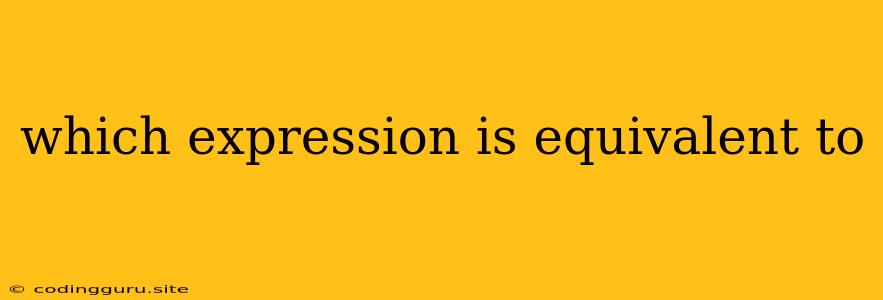Which Expression is Equivalent to: Mastering the Art of Algebraic Manipulation
In the world of mathematics, particularly algebra, we often encounter expressions that can be rewritten in different forms while retaining their original value. This process, known as "equivalent expressions", is crucial for simplifying equations, solving problems, and gaining a deeper understanding of the underlying relationships between variables.
But how do we determine if two expressions are truly equivalent? The answer lies in the principles of algebraic manipulation. This article will delve into the key concepts and strategies for recognizing and transforming expressions into their equivalent forms.
Understanding Equivalent Expressions
Two expressions are considered equivalent if they produce the same output for all possible values of their variables. To illustrate, let's take the example of the expressions 2x + 4 and 2(x + 2).
If we substitute any value for 'x' in both expressions, we will always get the same result. This is because the second expression has been simplified using the distributive property, but it represents the same underlying mathematical relationship.
Key Techniques for Finding Equivalent Expressions
Several techniques are commonly employed to find expressions equivalent to a given one. These include:
1. Distributive Property
This property states that multiplying a sum by a number is equivalent to multiplying each term of the sum by that number.
Example:
- Original Expression: 3(x + 5)
- Equivalent Expression: 3x + 15
2. Combining Like Terms
Like terms are those that have the same variable raised to the same power. We can combine them by adding or subtracting their coefficients.
Example:
- Original Expression: 2x + 3y + 5x - 2y
- Equivalent Expression: 7x + y
3. Factoring
Factoring involves breaking down an expression into a product of simpler expressions. This can be achieved through various methods like:
- Common Factor: Finding the greatest common factor among all terms.
- Difference of Squares: Factoring expressions in the form a² - b² as (a + b)(a - b).
- Perfect Square Trinomials: Recognizing and factoring expressions like a² + 2ab + b² as (a + b)² or a² - 2ab + b² as (a - b)².
Example:
- Original Expression: x² - 9
- Equivalent Expression: (x + 3)(x - 3)
4. Simplifying Rational Expressions
Rational expressions involve fractions with variables in the numerator and denominator. We can simplify them by canceling out common factors or by performing operations like addition, subtraction, multiplication, and division.
Example:
- Original Expression: (x² + 2x + 1) / (x + 1)
- Equivalent Expression: (x + 1)
Tips for Determining Equivalence
- Substitution: Substitute various values for the variables in both expressions. If they consistently yield the same output, they are likely equivalent.
- Rearrangement: Apply algebraic manipulations to one expression to see if it can be transformed into the other.
- Visual Representation: Graphing the expressions can help visualize their equivalence. If their graphs coincide, the expressions are equivalent.
Example Problems and Solutions
1. Which expression is equivalent to 4x + 12?
- Solution: We can factor out a 4 from both terms: 4x + 12 = 4(x + 3). Therefore, 4(x + 3) is equivalent to 4x + 12.
2. Which expression is equivalent to (x + 2)²?
- Solution: Expanding the square, we get (x + 2)² = (x + 2)(x + 2) = x² + 2x + 2x + 4 = x² + 4x + 4. Hence, x² + 4x + 4 is equivalent to (x + 2)².
3. Which expression is equivalent to (2x + 3)(x - 1)?
- Solution: Using the distributive property (FOIL method), we get (2x + 3)(x - 1) = 2x² - 2x + 3x - 3 = 2x² + x - 3. Thus, 2x² + x - 3 is equivalent to (2x + 3)(x - 1).
Conclusion
Understanding equivalent expressions is essential for navigating the world of algebra. By mastering the techniques of manipulation, we can simplify complex expressions, solve problems more efficiently, and gain a deeper appreciation for the beauty and interconnectedness of mathematical concepts. Remember to rely on the principles of algebraic manipulation and to employ various strategies to identify equivalent expressions. By practicing and exploring these techniques, you will become adept at recognizing and transforming expressions, ultimately enhancing your mathematical fluency.
